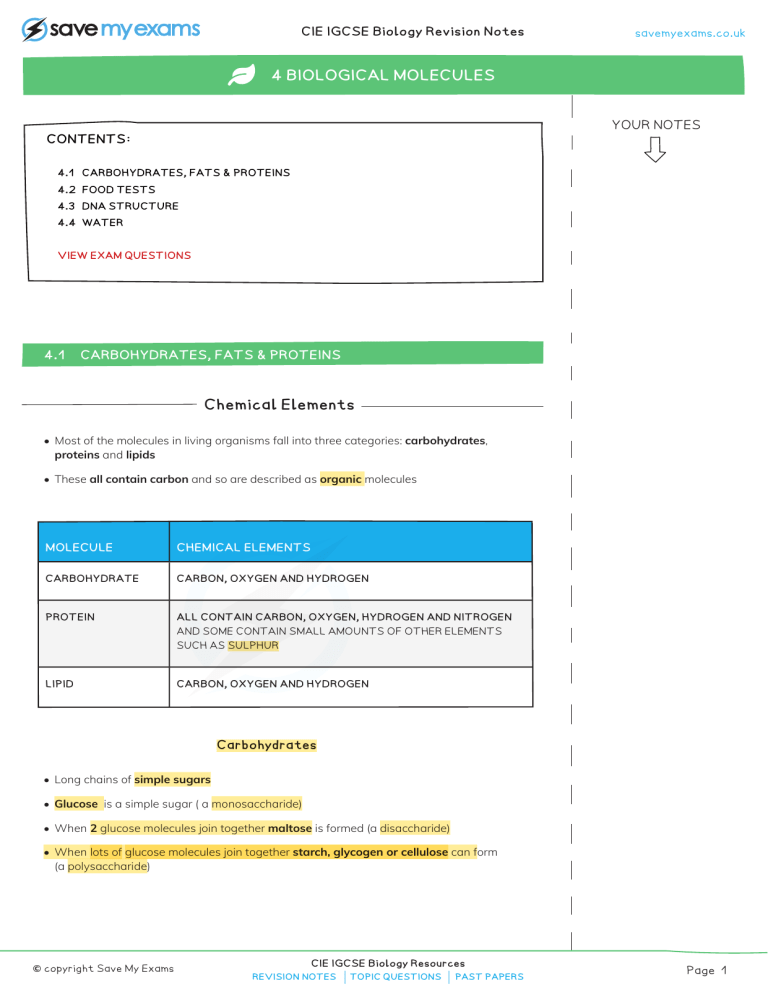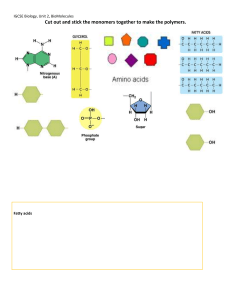
CIE IGCSE Biology Revision Notes savemyexams.co.uk 2 ORGANISATION 4 BIOLOGICAL OF MOLECULES THE ORGANISM YOUR NOTES CONTENTS: 4.1 CARBOHYDRATES, FATS & PROTEINS 4.2 FOOD TESTS 4.3 DNA STRUCTURE 4.4 WATER VIEW EXAM QUESTIONS 4.1 CARBOHYDRATES, FATS & PROTEINS Chemical Elements • Most of the molecules in living organisms fall into three categories: carbohydrates, proteins and lipids • These all contain carbon and so are described as organic molecules MOLECULE CHEMICAL ELEMENTS CARBOHYDRATE CARBON, OXYGEN AND HYDROGEN PROTEIN ALL CONTAIN CARBON, OXYGEN, HYDROGEN AND NITROGEN AND SOME CONTAIN SMALL AMOUNTS OF OTHER ELEMENTS SUCH AS SULPHUR LIPID CARBON, OXYGEN AND HYDROGEN Carbohydrates • Long chains of simple sugars • Glucose is a simple sugar ( a monosaccharide) • When 2 glucose molecules join together maltose is formed (a disaccharide) • When lots of glucose molecules join together starch, glycogen or cellulose can form (a polysaccharide) © copyright Save My Exams CIE IGCSE Biology Resources REVISION NOTES TOPIC QUESTIONS PAST PAPERS Page 1 CIE IGCSE Biology Revision Notes savemyexams.co.uk 4 BIOLOGICAL MOLECULES 4.1 YOUR NOTES CARBOHYDRATES, FATS & PROTEINS cont... Glycogen, cellulose and starch are all made from glucose molecules Fats • Most fats (lipids) in the body are made up of triglycerides • Their basic unit is one glycerol and three fatty acids • The fatty acids vary in size and structure • Lipids are divided into fats (solids at room temperature) and oils (liquids at room temperature) Structure of a triglyceride © copyright Save My Exams CIE IGCSE Biology Resources REVISION NOTES TOPIC QUESTIONS PAST PAPERS Page 2 CIE IGCSE Biology Revision Notes savemyexams.co.uk 2 ORGANISATION 4 BIOLOGICAL OF MOLECULES THE ORGANISM 4.1 YOUR NOTES CARBOHYDRATES, FATS & PROTEINS cont... Proteins • Long chains of amino acids • There are about 20 different amino acids • They all contain the same basic structure but the ‘R’ group is different for each one • When amino acids are joined together a protein is formed • The amino acids can be arranged in any order, resulting in hundreds of thousands of different proteins • Even a small difference in the order of the amino acids results in a different protein being formed General amino acid structure Amino acids join together to form proteins © copyright Save My Exams CIE IGCSE Biology Resources REVISION NOTES TOPIC QUESTIONS PAST PAPERS Page 3 CIE IGCSE Biology Revision Notes savemyexams.co.uk 4 BIOLOGICAL MOLECULES 4.1 YOUR NOTES CARBOHYDRATES, FATS & PROTEINS cont... EXTENDED ONLY Protein Shape • There are thousands of different proteins in the human body and other organisms • Many of these proteins are different shapes and the shape often has an important effect on the function of the protein • For example: • Enzymes have an area in them known as the active site – this is important as this is the place where another molecule fits into the enzyme in order for a reaction to take place • If the shape of the active site does not match the shape of the molecule that fits into it, the reaction will not take place • Every enzyme has a different shaped active site • Antibodies are proteins produced by certain types of white blood cell to attach to antigens on the surface of pathogens • The shape of the antibody must match the shape of the antigen so that it can attach to it and signal it for destruction • The different sequences of amino acids cause the polypeptide chains to fold in different ways and this gives rise to the different shapes of proteins • In this way every protein has a unique 3-D shape that enables it to carry out its function © copyright Save My Exams CIE IGCSE Biology Resources REVISION NOTES TOPIC QUESTIONS PAST PAPERS Page 4 CIE IGCSE Biology Revision Notes savemyexams.co.uk 2 ORGANISATION 4 BIOLOGICAL OF MOLECULES THE ORGANISM 4.2 YOUR NOTES FOOD TESTS Describing Food Tests Test for glucose (a reducing sugar) • Add Benedict’s solution into sample solution in test tube • Heat at 60 – 70 °c in water bath for 5 minutes • Take test tube out of water bath and observe the colour • A positive test will show a colour change from blue to orange or brick red The Benedict’s test for glucose Test for protein • Add drops of biuret solution to the food sample • A positive test will show a colour change from blue to violet / purple The biuret test for protein © copyright Save My Exams CIE IGCSE Biology Resources REVISION NOTES TOPIC QUESTIONS PAST PAPERS Page 5 CIE IGCSE Biology Revision Notes savemyexams.co.uk 4 BIOLOGICAL MOLECULES 4.2 YOUR NOTES FOOD TESTS cont... Test for starch using iodine We can use iodine to test for the presence or absence of starch in a food sample. The iodine test for starch • Add drops of iodine solution to the food sample • A positive test will show a colour change from orange–brown to blue-black Testing a potato to prove the presence of starch © copyright Save My Exams CIE IGCSE Biology Resources REVISION NOTES TOPIC QUESTIONS PAST PAPERS Page 6 CIE IGCSE Biology Revision Notes savemyexams.co.uk 2 ORGANISATION 4 BIOLOGICAL OF MOLECULES THE ORGANISM 4.2 YOUR NOTES FOOD TESTS cont... Test for lipids • Food sample is mixed with 2cm3 of ethanol and shaken • The ethanol is added to an equal volume of cold water • A positive test will show a cloudy emulsion forming The ethanol test for lipids Test for vitamin C • Add 1cm3 of DCPIP solution to a test tube • Add a small amount of food sample (as a solution) • A positive test will show the blue colour of the dye disappearing The DCPIP test for vitamin C EXAM TIP When describing food tests in exam answers, make sure you give the starting colour of the solution and the colour it changes to for a positive result. © copyright Save My Exams CIE IGCSE Biology Resources REVISION NOTES TOPIC QUESTIONS PAST PAPERS Page 7 CIE IGCSE Biology Revision Notes savemyexams.co.uk 4 BIOLOGICAL MOLECULES 4.3 YOUR NOTES DNA STRUCTURE EXTENDED ONLY Describing DNA Structure • DNA, or deoxyribonucleic acid, is the molecule that contains the instructions for growth and development of all organisms • It consists of two strands of DNA wound around each other in what is called a double helix DNA, chromosomes and the nucleus • The individual units of DNA are called nucleotides A nucleotide © copyright Save My Exams CIE IGCSE Biology Resources REVISION NOTES TOPIC QUESTIONS PAST PAPERS Page 8 CIE IGCSE Biology Revision Notes savemyexams.co.uk 2 ORGANISATION 4 BIOLOGICAL OF MOLECULES THE ORGANISM 4.3 YOUR NOTES DNA STRUCTURE cont... EXTENDED ONLY cont... • All nucleotides contain the same phosphate and deoxyribose sugar, but differ from each other in the base attached • There are four different bases, Adenine (A), Cytosine (C), Thymine (T) and Guanine (G) • The bases on each strand pair up with each other, holding the two strands of DNA in the double helix • The bases always pair up in the same way: • Adenine always pairs with Thymine (A-T) • Cytosine always pairs with Guanine (C-G) DNA Base Pairs • The phosphate and sugar section of the nucleotides form the ‘backbone’ of the DNA strand (like the sides of a ladder) and the base pairs of each strand connect to form the rungs of the ladder © copyright Save My Exams CIE IGCSE Biology Resources REVISION NOTES TOPIC QUESTIONS PAST PAPERS Page 9 CIE IGCSE Biology Revision Notes savemyexams.co.uk 4 BIOLOGICAL MOLECULES 4.3 YOUR NOTES DNA STRUCTURE EXTENDED ONLY cont... The DNA helix is made from two strands of DNA held together by hydrogen bonds • It is this sequence of bases that holds the code for the formation of proteins EXAM TIP You do not need to learn the names of the bases, just their letter. Know which bonds with which as this is the most commonly asked question about this topic. © copyright Save My Exams CIE IGCSE Biology Resources REVISION NOTES TOPIC QUESTIONS PAST PAPERS Page 10 CIE IGCSE Biology Revision Notes savemyexams.co.uk 2 ORGANISATION 4 BIOLOGICAL OF MOLECULES THE ORGANISM 4.4 YOUR NOTES WATER Importance as a Solvent • Water is important for all living organisms as many substances are able to dissolve in it (it is a solvent) • This makes it incredibly useful and essential for all life on Earth EXTENDED ONLY Role within Organisms Water is important as a solvent in the following situations within organisms: • Dissolved substances can be easily transported around organisms – eg xylem and phloem of plants and dissolved food molecules in the blood • Digested food molecules are in the alimentary canal but need to be moved to cells all over the body – without water as a solvent this would not be able to happen • Toxic substances such as urea and substances in excess of requirements such as salts can dissolve in water which makes them easy to remove from the body in urine • Water is also an important part of the cytoplasm and plays a role in ensuring metabolic reactions can happen as necessary in cells Water as a solvent > NOW TRY SOME EXAM QUESTIONS © copyright Save My Exams CIE IGCSE Biology Resources REVISION NOTES TOPIC QUESTIONS PAST PAPERS Page 11 CIE IGCSE Biology Revision Notes savemyexams.co.uk 4 BIOLOGICAL MOLECULES YOUR NOTES EXAM QUESTIONS ? QUESTION 1 Large food molecules are composed from smaller molecules chemically bonded together. Which of the following statements is false? A Glucose molecules are the basic units of cellulose B Glycerol is a basic unit of oils. C Simple sugars like glucose are the basic unit of fats. D Amino acids are basic units of proteins. ? QUESTION 2 DNA is a large molecule made from two chains of nucleotides held together by cross-links between pairs of bases. Which of the following is a correct base pair? A T with C B G with A C C with G D C with A ? QUESTION 3 A group of students tested four different foods using some common food tests. Their results are shown in the table below. Which food contains reducing sugar and Vitamin C but not protein or starch? Benedict’s test Biuret test Iodine test DCPIP test A brick-red purple brown colourless B brick-red blue brown colourless C blue blue black blue D brick-red blue black colourless © copyright Save My Exams CIE IGCSE Biology Resources REVISION NOTES TOPIC QUESTIONS PAST PAPERS Page 12 CIE IGCSE Biology Revision Notes savemyexams.co.uk 2 ORGANISATION 4 BIOLOGICAL OF MOLECULES THE ORGANISM YOUR NOTES EXAM QUESTIONS cont... ? QUESTION 4 A strand of DNA is shown below: T―G―A―A―C―T―A―G―C―C What would the correct order of bases be on the complementary strand of DNA? A A―C―T―T―A―A―T―C―G―G B C―A―G―G―T―C―G―A―T―T C T ― G ― A ― A ― C ― T ― A ― G ― C ― C D A ― C ― T ― T― G ― A ― T ― C ― G ― G ? QUESTION 5 Three statements about proteins are given below. 1 Different sequences of amino acids give different shapes to protein molecules 2 Amylase is made from a sequence of amino acids joined together forming a non-specific 3D shape. 3 When mixed with Biuret solution, there is a colour change from blue to purple. Which of the statements above are true? A 1 & 2 only B 1, 2 & 3 C 1 & 3 only D 3 only > CHECK YOUR ANSWERS AT SAVEMYEXAMS.CO.UK Head to savemyexams.co.uk for more questions and revision notes © copyright Save My Exams CIE IGCSE Biology Resources REVISION NOTES TOPIC QUESTIONS PAST PAPERS Page 13


